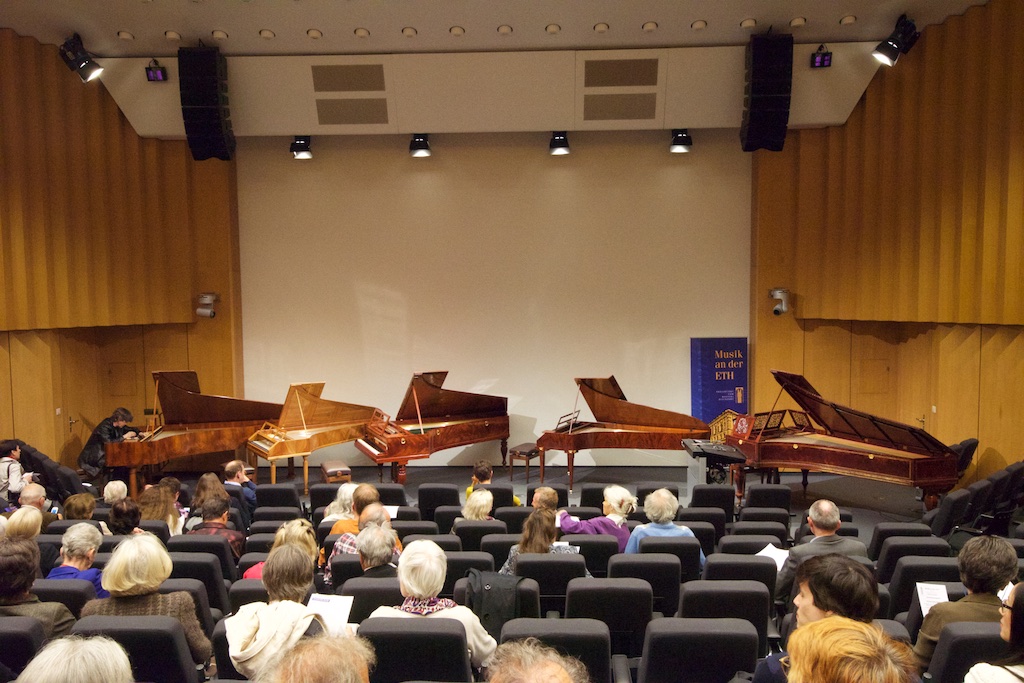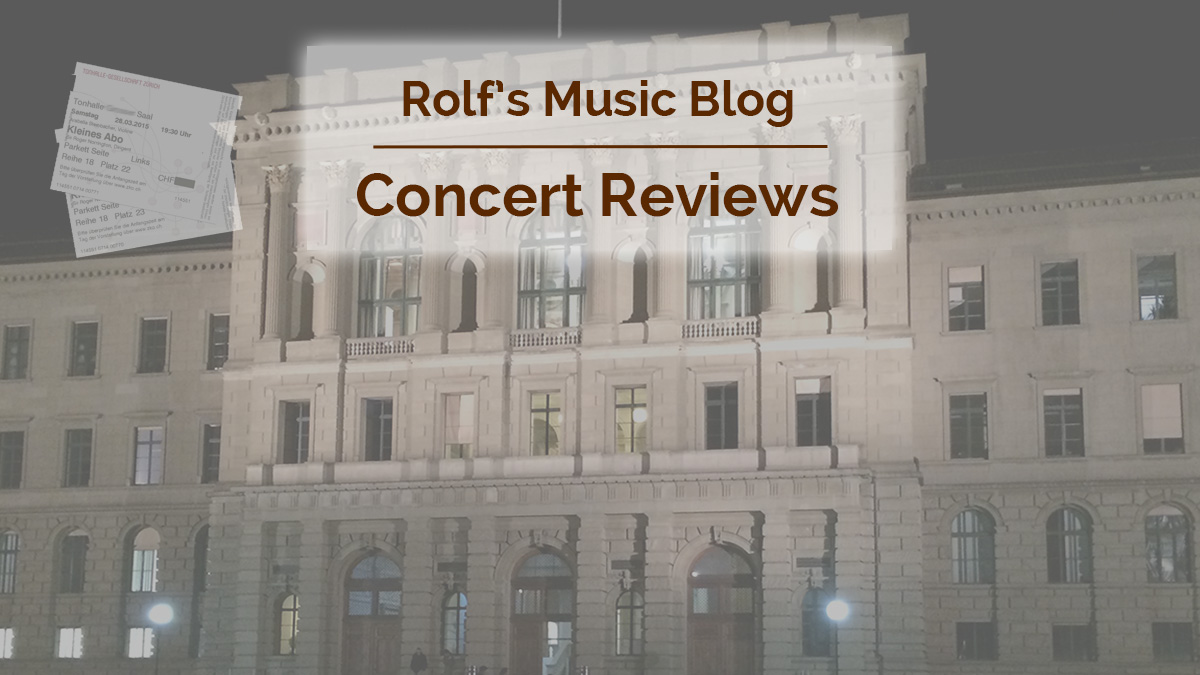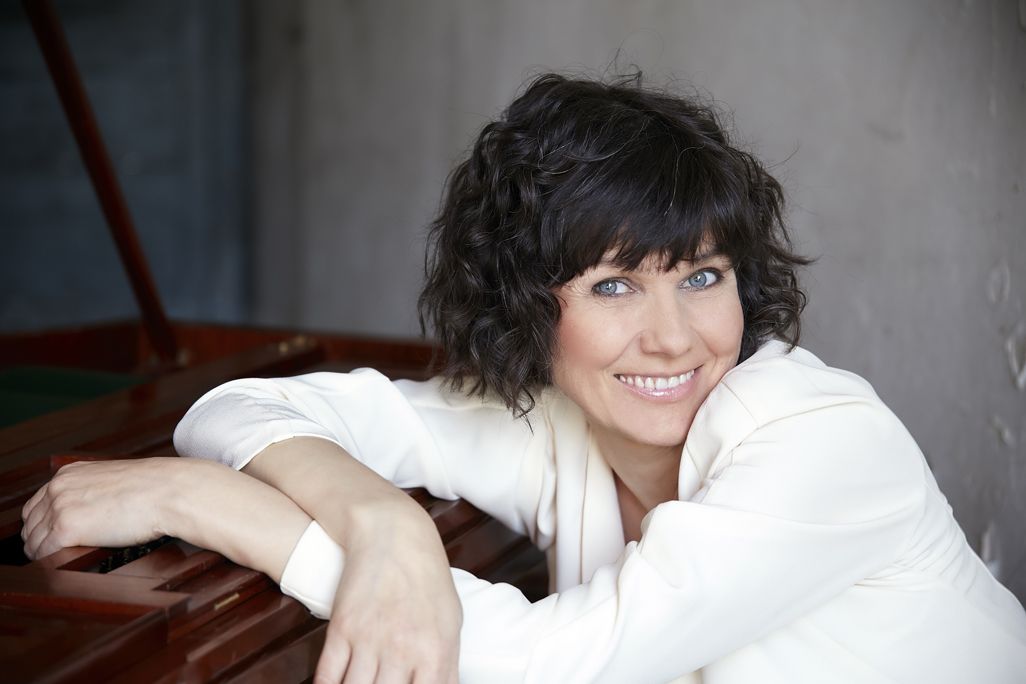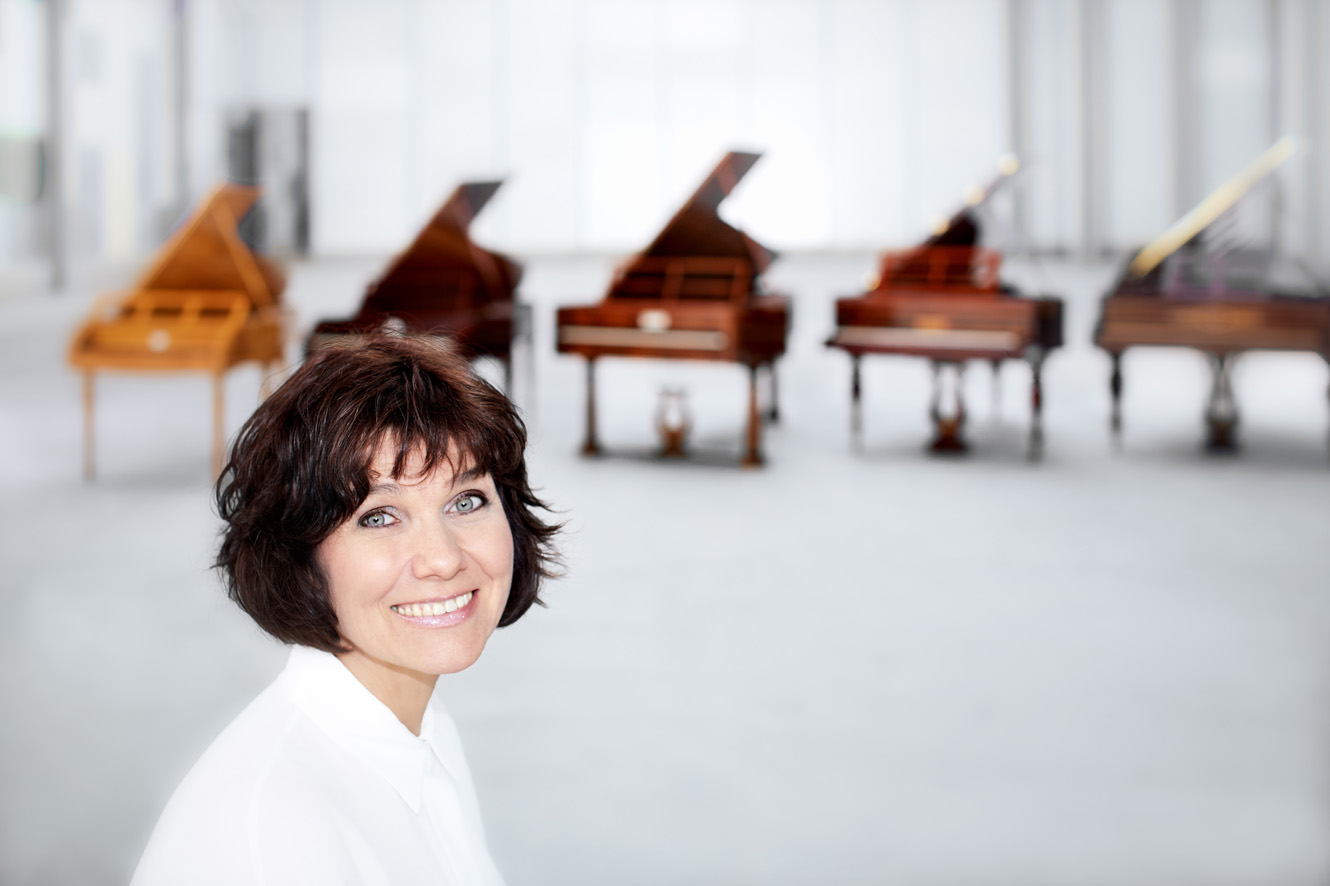(Forte-)Piano Recital: Viviana Sofronitsky
The Early History of the Piano: 5 Replicas by Paul McNulty
Auditorium maximum, ETH Zurich, 2016-05-17

2016-05-20 — Original posting
2016-10-13 — Brushed up for better readability
Table of Contents
Introduction
The Pianist
Let me first write about the pianist, Viviana Sofronitsky. Her name will sound familiar, particularly with the elder generations. In fact, Viviana (born 1960) is the daughter of Vladimir Sofronitsky (1901 – 1961), one of the most highly praised pianists of the 20th century in Russia. When Sofronitsky died, Emil Gilels even called him the “greatest pianist of the world”. With one single exception (1949), Vladimir Sofronitsky never played in concerts in Western Countries. Therefore, he remained largely unknown here. As he died before Viviana was two years old, she can’t have inherited (directly) more than the genes from her father. I could actually imagine that living in the shadow of such a high-reputation father can be a real burden!
Viviana Sofronitsky studied piano (DMA) at the Moscow Conservatory. She then started performing also early music. 1989, she moved to the US, where she worked at the Oberlin College Conservatory of Music in Ohio. In the following year, 1990, she moved to Toronto / Canada (1994, she earned a Canadian citizenship). 1999, she graduated in historical fortepiano, harpsichord, and early music teaching from the Royal Conservatory in The Hague. Since 2001, Viviana Sofronitsky lives in Divisov / CZ, now married to the fortepiano builder Paul McNulty (see below). She is pursuing a concert career with the instruments and the repertoire also featured in this concert, throughout Europe. For more information see Wikipedia.
Concert and Venue
On to the concert, which was also the last concert of the season 2015/16 in the framework of “Musik an der ETH“, organized by Musical Discovery. It was a most unusual piano recital, for sure, in several ways! The final concert in the season is typically a bigger event, attracting a bigger audience. Therefore, it is not taking place in the venerable, historic Semper-Aula, but rather in the modern Auditorium maximum within the same building. There was a second reason for the selection of a bigger venue: there was a need to place not just one or two pianos, but five keyboard instruments. Also, the Auditorium maximum gives the instruments on display a far better visibility throughout the audience.

Paul McNulty & His Instruments
This recital is one of many that Viviana Sofronitsky is giving in various locations throughout Europe. She is traveling with her husband: the American Paul McNulty, born 1953. Together, they are presenting five replicas of historical fortepianos (predecessors of the modern piano) from the time between 1788 and 1846.
All these instruments are newly built by her husband, a true perfectionist and maniac. McNulty has earned the highest reputation for his fortepiano replicas. For many years he manufactured these in The Netherlands. Initially, his instrumewnts were based on historical models by Anton Walter (dated 1790 – 1805) and Conrad Graf (dated 1819 – 1826). Well-known artists such as Ronald Brautigam, Kristian Bezuidenhout, Robert Levin and several other now play such replicas in concerts and recordings.
A Move to Divisov, CZ
In the meantime, Paul McNulty (now married to Viviana Sofronitsky) has moved to Divisov, CZ. One major reason for the move was that Conrad Graf (almost 200 years ago!) claimed that that’s where the ideal wood for such instrument is growing. In his new manufacturing workshop, he has now expanded the spectrum of replicas. He is now also building instruments after Johann Andreas Stein (dated 1788), Ignaz Pleyel (1830), Boisselot & Fils (1846), and after a model by Streicher (1868). With the exception of the latter (Johannes Brahms’ favorite instrument), all these models were present in the concert, as shown above, crammed into the width of the podium.
Every single one is built to highest manufacturing standards, with meticulous attention to the tiniest of details in the historic model instruments. It was a true feast for the eye, not just from the audience, but also in close-up view. After the concert, the visitors could admire and directly inspect the instruments on the podium. Those who dared touching these precious jewels even had a chance to play them.
A Sales Event?
In a way, all this might sound like a sales promotion event (or tour) for Paul McNulty’s instruments. Of course, it might even be that this recital triggered one or the other instrument purchase. However, one should keep in mind that virtually all concert halls of this world still still only have “black monsters” (i.e., modern concert grands) at their disposal (and within these, there is again a quasi-monopoly of a single brand).
We have seen tremendous efforts and success in the area of historically informed playing over the past decades. Also, one can observe growing success of recordings with artists such as those mentioned above (Brautigam, Bezuidenhout, Levin and others). Still, live concert performances on the fortepiano are rare exceptions. And they happen in very few, specific venues only.
This means that the vast majority of the concertgoers today still has no clue how these instruments sound in a live environment. And with this, they also don’t know how classical and early romantic keyboard works originally sounded. Or, how they must have sounded to the composer’s inner ear. Therefore, education in this area is highly welcome!
Last, but not least: Paul McNulty has been very successful with his instruments. He now has such a prominent presence in the “HIP scene”, that he barely has a need for extra promotion. And after all, there are only so many (or few) instruments that he can build in his workshop!
Rare Occurrences on Concert Stage
I should add that there are more reasons for early pianos, such as the fortepianos after Stein, Walter, and Graf, to be so rare on concert podiums: these are all-wooden instruments. This implies that they don’t feature a cast iron frame like modern concert grands. That makes them susceptible to de-tuning due to changes in humidity and (to a lesser degree) temperature. They need to be tuned frequently, possibly even re-tuned during a concert. Paul McNulty was literally tuning the Graf fortepiano up to the very last minute prior to the concert!
In addition, they are very delicate and nowhere near the robustness of a modern concert grand. Overall, any owner of such instruments will want to see them transported and handled with extreme care, and by experts only. So, any concert with fortepiano requires extra time, manpower, expert knowledge, and resources. In a studio environment, this may be manageable, but for concerts this also means more stage time. Worse even: if an orchestra is involved, this multiplies the potential resource consumption.
The Purpose of this Concert?
With all this, it is obvious that the primary objective of this particular concert could not be to present compositions and their interpretation. Neither could it be a platform to show off the pianistic / virtuosic abilities of the artist. Rather, the aim was to present the instruments and their specific advantages for the music played.
Needless to say that this was not a competition between the instruments. The question “which is the best instrument?” that Viviana Sofronitsky asked before presenting a brief “summary comparison” as encore was purely rhetorical. Rather, the concert was meant to present samples of the specific advantages for the music written at the time / epoch when each of these instruments was built, respectively.
Following the Rapid Evolution of Keyboard Instruments
At the classic and early romantic time, the evolution of keyboard instruments (in particular, pianos / fortepianos) was very rapid, even dramatic. Even the newest and best instruments of any given time were outdated after 20 – 30 years. They were (and are) indeed unusable for later music, even just from the almost constant demand for a larger tonal range. Conversely, older music can theoretically be played on newer instruments. However, the sound characteristics then are likely inappropriate for older works. A composer could not anticipate all of the future development in these instruments. So, in lieu of a broad discussion of the compositions played, and describing their interpretation, I will focus on my impressions about the sound of the instruments.
Fortepiano vs. Pianoforte vs. Piano, etc.
The naming of these instruments in literature, as well as by manufacturers, etc. is somewhat variable, if not arbitrary. I’m using the term “fortepiano” for instruments with a purely wooden structure (similar to harpsichords, but featuring a keyboard action using wooden hammers and hammer heads covered with either leather or later felt). The newer instruments by Pleyel and Boisselot feature a cast iron frame (which Pleyel invented) and a distinctly heavier, more robust structure. There, I use the term “grand piano” or “piano” (which in itself of course is the abbreviated form of “pianoforte“).
Often, people use the term Hammerklavier, but that is mis-leading. All fortepianos, pianos and concert grands are variations of a Hammerklavier, i.e., piano with an action using hammers rather than plucking. In his “Hammerklavier-Sonate”, Beethoven was referring to fortepiano models such as those by Graf (or Broadwood).
Replica vs. Original
Another, brief remark: some people may argue that these are “merely” replicas that can’t possibly represent the sound of the original at its time. That’s basically true: we cannot know exactly how the originals really sounded. However, invariably, these originals (now mostly in museums / exhibitions) have aged, their mechanics / action is worn out, whether the instrument is, used or not. Paul McNulty mentioned that in Liszt’s Boisselot, the action was virtually unusable after 20 – 30 years of playing. Restoring the action is hardly an option, as this destroys essential parts of the original. Thus, we would end up with a partial replica again. Hence, good replicas are the best option there is. And McNulty’s are among the best available.
Fortepiano after Johann Andreas Stein, 1788
The Instrument
The concert started with the earliest fortepiano model, the replica of an instrument from 1788, built by Johann Andreas Stein (1728 – 1792). It’s a a small, light and delicate instrument in bright wood. It looks almost identical to a harpsichord. And it probably has lots if the latter’s fragility.
The Composition
On this instrument, the artist played a composition by Carl Philipp Emanuel Bach (1714 – 1788): the Sonata in G minor, Wq.65/17. This was composed 1746, with the three movements Allegro — Andante — Allegro assai.
The Performance
Here, I should say that I was skeptical about the acoustics of the venue, in particular with such instruments that don’t come close to the volume of a modern concert grand. However, I was very pleasantly surprised when I realized that the acoustics were clear—even though devoid of reverberation and cosy atmosphere. None of the instruments had a problem projecting into the remotest corners of the hall, and all details of the sound were clearly audible.
In this case, I experienced an instrument with a bright, singing tone. This was ideally exposed in the preluding section, or in the recitativo-like passages. The singing character of the tone is a consequence of the light, relatively hard (leather-clad) hammers and the thin wire of the strings. However, I also believe that a slight non-equal temperament tuning (Vallotti tuning? I did not ask…) contributed to this. In parts, a slight degradation in tuning in the dry atmosphere of the auditorium may have contributed, too. The tuning must have happened more than half an hour earlier.
What amazed me most, though, was not the (somehow harpsichord-like) tone, but the astonishing volume that came out of such a delicate instrument. Quite obviously, the articulation on these instruments is radically different from that on a modern piano, given the agility of the action in a Stein fortepiano. This definitely also applies to the Walter and Graf instruments, see below.
Fortepiano after Anton Walter, 1792
The Instrument
The program then progressed to the other instruments, all in chronological order. Next was a replica after a fortepiano from 1792, by the Viennese manufacturer Gabriel Anton Walter (1752 – 1826). In my experience from CD recordings, Walter instruments are the most colorful, the most singing fortepianos, ideally suited for music by Mozart and the early Beethoven. Conversely, they were these composer’s favorites at the time.
The Composition
Viviana Sofronitsky selected three pieces for this instrument. The first two were by Wolfgang Amadeus Mozart (1756 – 1791): the Fantasia No.3 in D minor, K.397 (Andante – Adagio – Presto – Tempo I – Presto – Tempo I – Allegretto), followed by the Rondo in D major, K.485 (Allegro). The artist followed up with the well-known Piano Sonata No.14 in C♯ minor, op.27/2 (“Sonata quasi una Fantasia” / “Moonlight Sonata”) by Ludwig van Beethoven (1770 – 1827). This features three movements: Adagio sostenuto — Allegretto — Presto agitato.
The Performance
My high expectations were not disappointed. Not even in this acoustically dry environment. The richness in colors and the singing tone of these instruments is unmatched—a true delight for the ear! The acciaccaturas in the Mozart pieces were an opportunity to demonstrate the agility of the action with this instrument: this makes a modern concert grand sound clumsy. I also had the impression that the tuning on the Walter instrument is more stable than that of the Stein fortepiano. But maybe the former had been tuned after the latter instrument?
In the first movement of Beethoven‘s “Moonlight Sonata” (a title not given by the composer) we had the opportunity to experience the effect of the moderator. That is a pedal (or on this instrument a lever similar to that for the dampers, operated with the knees) that causes a piece of cloth (or leather) to be pulled between the hammers and the strings. This makes the tone softer, darker, somewhat blurred, creating a mysterious, veiled atmosphere. The second movement of that sonata felt almost Mozartian, sent us back into the Rococo times. This only increased, dramatized the contrast to the final movement. At its time, this was mind-boggling, revolutionary, dramatic music, with an explosion in emotions that was unheard of till then. Compared to modern instruments, the fortepiano even amplified the drama, the expression in this music!
Fortepiano after Conrad Graf, 1819
The Instrument
The next instrument (presented after the intermission) was the replica of a fortepiano from 1819, by the Austrian manufacturer Conrad Graf (1782 – 1851). This type of instrument is ideally suited for music by the late Beethoven, or by Schubert. It is heavier, larger, more sturdy than the instruments by Walter, but still essentially all wooden, hence rather frail in the tuning. One innovation here (besides the larger tonal range) is in the foot-operated pedals. These control the dampers, the shifting (una corda), and the moderator, allowing faster switching of the moderator.
The Composition
For this instrument, Viviana Sofronitsky selected the Impromptu in B♭ major, op.posth.142, No.3, D.935, by Franz Schubert (1797 – 1828), a theme (Andante) with five variations.
The Performance
In this composition, the pianist demonstrated the option to add or remove the moderator for short phrases. Beyond what is available already through dynamics and alterations to the keyboard touch, this had the effect of even expanding the fascinating richness in colors. The instrument also offers more volume. The most amazing feature for me, though, was the effect of the shift pedal. On a modern grand piano, the effect of that pedal (due corde — una corda) is very subtle, often hardly noticeable. However, here, the tone quality changes to the most enchanting harp-like sound. It sounded even better (certainly more versatile in modulations, etc.) than a typical harp, I would say! I have numerous recordings with this type of fortepiano: none of them really explores this option—certainly not to the extend demonstrated by Viviana Sofronitsky.
Piano after Ignaz Pleyel, 1830
The Instrument
With the next instrument, we definitely found ourselves in the romantic period. We experienced the replica of an early piano, now with steel frame. The original was built 1830 by the Austrian-born French composer and piano builder Ignace Joseph (Ignaz) Pleyel (1757 – 1831). As all the other instruments used in this concert (and just like all harpsichords), this features a parallel string arrangement, as opposed to the crossed string setup in most modern pianos and concert grands. The parallel setup offers a distinctly larger variation in sound / tonal quality over the range of the keyboard. Pianists often talk about bass vs. descant “registers” in pianos and concert grands. Here, this terminology really makes sense.
The Composition
To demonstrate this, the artist chose to play the Nocturne in C minor, op.48, No.1 (Lento — Poco più lento — Doppio movimento agitato) by Frédéric Chopin (1810 – 1849). The instruments by Pleyel were typical of what Chopin used once he moved to Paris.
The Performance
The tonal colors of a modern concert grand are simply incomparable to those in such an instrument. At the beginning of the Nocturne, the left hand created a dark, but still clear foundation. At times, the right hand appeared be relatively close to a modern piano sound. However, when needed, it could also turn to be very brilliant, shining and melodic. In the sotto voce in the Poco più lento part, the audience could again enjoy the softening / darkening effect of the moderator. Then, when the octave parallels start, the music turns extremely dramatic, with a rumbling thunderstorm in the left hand. At the same time, the right hand deployed truly orchestral richness and colors. It felt like a large brass section: very impressive, and far beyond what a modern piano can achieve!
Grand Piano after Boisselot & Fils, 1846
The Instrument
The final instrument in the concert was the replica of a grand piano from 1846, by Boisselot & Fils. This was a manufacturing company, founded 1831 in Marseille, which existed up to the beginning of the First World War. Among all the replicas in this concert, the Boisselot is a real marvel in artistic decoration, fine ornamentation, and precious woods. The model for this replica was Franz Liszt’s favorite instrument. He kept this in Weimar for the rest of his life. Liszt must have really liked this piano!
The Composition
Consequently, Viviana Sofronitsky chose to play No.7, “Funérailles” from the Harmonies poétiques et religieuses, S.173 by Franz Liszt (1811 – 1886). The composer wrote “Les Funérailles” (Adagio — Allegro energico assai — Più lento) in 1849. That’s the year in which Liszt’s friend Chopin died. In the second half, the piece features a bass line that resembles that of Chopin’s “Heroic” Polonaise, op.53. Liszt claimed that he did not write this with Chopin in mind—see Wikipedia for details.
The Performance
Just like a Pleyel piano, the Boisselot features a steel frame and all-parallel strings (hence registers / more sound colors, and additional transparency). However, it is again bigger and heavier. It can produce a volume close to that of a modern concert grand. One peculiarity of this instrument (which it shares with the older Broadwood fortepianos) is in the short / small dampers. These have only a limited effect. Unlike on modern instruments, one cannot shut off a loud note (particularly in the bass) instantly. The tone is merely attenuated and partially shortened.
The choice of music for this instrument was excellent. In the “heroic” bass section, the left hand produced a real thunderstorm. This was even amplified by the blurring / mixing (“al fresco” effect) caused by the limited efficiency of the dampers. At the same time the right hand produced a firework of sparkling lights. I found the long resonance of this instrument (particularly in the bass) very impressive. But I equally enjoyed the general richness in harmonics, almost up to a twanging in very loud notes in the middle and low registers. It was a very interesting experience, indeed!
Encores
As mentioned initially, Viviana Sofronitsky did not just play a simple encore on a single instrument of her choice. She rather asked the rhetoric question: “which instrument is best?”. She went on playing small fragments on seemingly arbitrarily selected instruments. With this, she merely / solely demonstrated that there is no single, ideal instrument. Rather, each composition is best played on an instrument from the time when it was written. This clearly was the obvious and expected outcome.
Conclusions
In this concert, the listeners had the luxury and the pleasure of experiencing five precious replicas, transported here, set up and tuned carefully by their creator, Paul McNulty. And all this for a few minutes of music per instrument only. However, each of these instruments is a gem in itself. Every instrument played can be considered an ideal choice only for music created in the time when they were built. And each covers a specific period of maybe 30 – 50 years in musical evolution.
Whenever Viviana Sofronitsky switched between keyboards, Paul McNulty offered some explanation on the specifics of the respective instrument. During such intervals, the pianist changed to the appropriate dress for that period.
Viviana Sofronitsky entirely dedicated her playing to the presentation of the five instruments, their features and specific advantages / characteristics. She couldn’t possibly have aimed at presenting herself as keyboard virtuosa. This was not really an option: each of these instruments requires its own, specific playing techniques (articulation, keyboard touch, pedal control, etc.). However, I would definitely state that the artist did an excellent job at presenting the specific advantages and features of Paul McNulty’s five marvels in this concert. It was a really enriching evening that stimulated the appetite for more music played on such instruments!
Addendum
For the same concert, I have also written a (shorter) review in German for Bachtrack.com. This posting is not a translation of that German review, the rights of which remain with Bachtrack. I create the German review using a subset of the notes taken during this concert. I wanted to enable my non-German speaking readers to read about my concert experience as well. Therefore, I have taken my original notes as a loose basis for this separate posting. I’m including additional material that is not present in the Bachtrack review.



